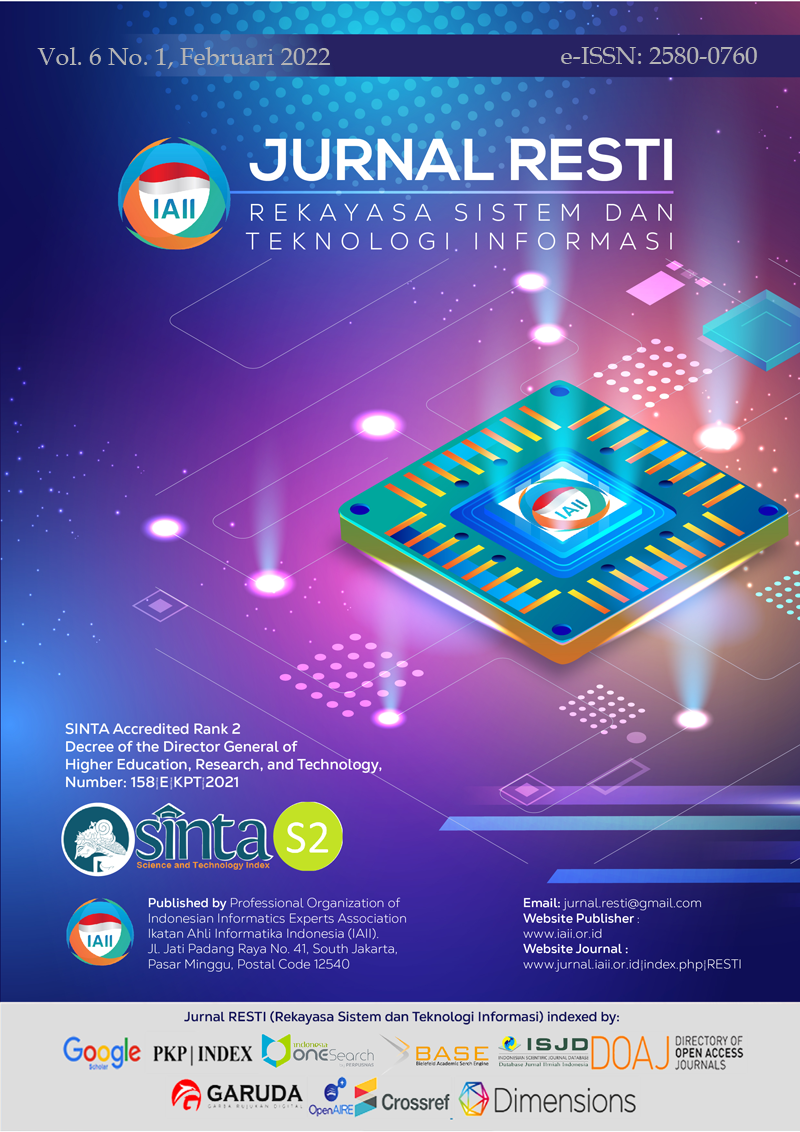Design of Smart Farm Irrigation Monitoring System Using IoT and LoRA
Abstract
Agriculture is an essential part of society in Indonesia because most of the population lives off of farming. Water and irrigation are the most critical and central factors in the agricultural system. The uneven distribution of irrigation water can be a problem for farmers. In addition, most of the current irrigation systems are still operated manually, for example, irrigation gates. The gate still works manually and requires human labor to run it. This study aims to design a smart farm irrigation system using internet of things and LoRa communication technology. LoRa can transmit information up to a range of several kilometers without an internet connection. It will be advantageous when the farm's location is deep in the forest, and there is no GSM signal for internet access. This study indicates that this system brings benefits for farmers in running agriculture. Farmers' work time is shorter. They can use the remaining time to do other businesses to increase their income. The irrigation monitoring process becomes easier because they do not need to come to the farm location. In fact, they can use smartphones to monitor it.
Downloads
References
P. Saccon, “Water for agriculture, irrigation management,” Appl. Soil Ecol., vol. 123, no. October, pp. 793–796, 2018, doi: 10.1016/j.apsoil.2017.10.037.
Y. Zou et al., “Water use conflict between wetland and agriculture,” J. Environ. Manage., vol. 224, no. March, pp. 140–146, 2018, doi: 10.1016/j.jenvman.2018.07.052.
H. Plusquellec, “Modernization of large-scale irrigation systems: Is it an achievable objective or a lost cause,” Irrig. Drain., vol. 58, no. SUPPL. 1, pp. 104–120, 2009, doi: 10.1002/ird.488.
D. Masseroni et al., “Evaluating performances of the first automatic system for paddy irrigation in Europe,” Agric. Water Manag., vol. 201, pp. 58–69, 2018, doi: 10.1016/j.agwat.2017.12.019.
J. M. Maestre, P. J. Van Overloop, M. Hashemy, A. Sadowska, and E. F. Camacho, “Human in the Loop Model Predictive Control: an Irrigation Canal Case Study,” in 53rd IEEE Conference on Decision and Control December 15-17, 2014. Los Angeles, California, USA Human, 2014, pp. 4881–4886.
R. Ahadi, Z. Samani, and R. Skaggs, “Evaluating on-farm irrigation efficiency across the watershed: A case study of New Mexico’s Lower Rio Grande Basin,” Agric. Water Manag., vol. 124, pp. 52–57, 2013, doi: 10.1016/j.agwat.2013.03.010.
H. Long, S. Tu, D. Ge, T. Li, and Y. Liu, “The allocation and management of critical resources in rural China under restructuring: Problems and prospects,” J. Rural Stud., vol. 47, pp. 392–412, 2016, doi: 10.1016/j.jrurstud.2016.03.011.
A. Tzounis, N. Katsoulas, T. Bartzanas, and C. Kittas, “Internet of Things in agriculture, recent advances and future challenges,” Biosyst. Eng., vol. 164, pp. 31–48, 2017, doi: 10.1016/j.biosystemseng.2017.09.007.
A. Zourmand, A. L. Kun Hing, C. Wai Hung, and M. Abdulrehman, “Internet of Things (IoT) using LoRa technology,” in 2019 IEEE International Conference on Automatic Control and Intelligent Systems, I2CACIS 2019 - Proceedings, 2019, no. June, pp. 324–330, doi: 10.1109/I2CACIS.2019.8825008.
B. M. Leiner et al., “The past and future history of Regulus,” Communications of the ACM, vol. 40, no. 2, pp. 102–108, 1997.
L. Atzori, A. Iera, and G. Morabito, “The Internet of Things: A survey,” Comput. Networks, vol. 54, no. 15, pp. 2787–2805, 2010, doi: 10.1016/j.comnet.2010.05.010.
M. Z. U. Haq, A. Anwar, M. I. Ullah, U. Zafar, and S. L. Ijaz, “Challenges of Practical Implementation of Internet of Things in Agriculture,” J. Inf. Eng. Appl., vol. 9, no. 7, pp. 17–22, 2019, doi: 10.7176/jiea/9-7-02.
E. Y. T. Adesta, D. Agusman, and Avicenna, “Internet of things (IoT) in agriculture industries,” Indones. J. Electr. Eng. Informatics, vol. 5, no. 4, pp. 376–382, 2017, doi: 10.11591/ijeei.v5i4.373.
L. Zhang, I. K. Dabipi, and W. L. Brown, “Internet of Things Applications for Agriculture,” in Internet of Things A to Z: Technologies and Applications, 2018.
D. Setiadi, A. Muhaemin, and M. Nurdin, “PENERAPAN INTERNET OF THINGS (IoT) PADA SISTEM MONITORING IRIGASI (SMART IRIGASI),” Infotronik J. Teknol. Inf. dan Elektron., vol. 3, no. 2, p. 95, 2018, doi: 10.32897/infotronik.2018.3.2.108.
M. D. Syamsiar, M. Rivai, and S. Suwito, “Rancang Bangun Sistem Irigasi Tanaman Otomatis Menggunakan Wireless Sensor Network,” J. Tek. ITS, vol. 5, no. 2, 2016, doi: 10.12962/j23373539.v5i2.16512.
I. Khan, “Suitability of LoRa, SigFox and NB-IoT Different Internet-of-Things Applications,” 2019.
M. Bor, J. Vidler, and U. Roedig, “LoRa for the Internet of Things,” 2016.
Espressif, “ESP32 Series Datasheet,” Espressif Systems, 2021. https://www.espressif.com/sites/default/files/documentation/esp32_datasheet_en.pdf (accessed Dec. 08, 2021).
Hope Microelectronics Co., “Datasheet: RFM95/96/97/98(W) v1.0,” 2014. http://www.hoperf.com/upload/rf/RFM95_96_97_98W.pdf (accessed Dec. 08, 2021).
Copyright (c) 2022 Jurnal RESTI (Rekayasa Sistem dan Teknologi Informasi)

This work is licensed under a Creative Commons Attribution 4.0 International License.
Copyright in each article belongs to the author
- The author acknowledges that the RESTI Journal (System Engineering and Information Technology) is the first publisher to publish with a license Creative Commons Attribution 4.0 International License.
- Authors can enter writing separately, arrange the non-exclusive distribution of manuscripts that have been published in this journal into other versions (eg sent to the author's institutional repository, publication in a book, etc.), by acknowledging that the manuscript has been published for the first time in the RESTI (Rekayasa Sistem dan Teknologi Informasi) journal ;







